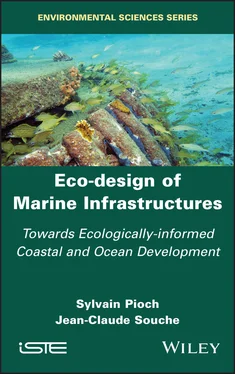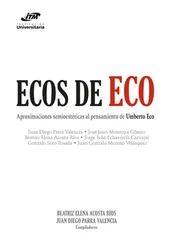The first modern (disseminated) Japanese studies on AHs date back to 1903 (Fukuoka Prefecture), with the most important trials starting in 1952 with the first governmental plan for “development of shallow water fishing areas” (Simard 1996). The Japanese public investment for the creation of AH infrastructures in 2007 alone was 602 million euros (93.318 billion yen), with an average between 2000 and 2005 that was fairly stable at approximately 600 million euros per year (Japanese Institute of Fisheries Infrastructure and Community 17). In 2001, an audit launched by the French Ministry of Agriculture, Fisheries and Forestry (MAFF) found that more than 12% of the continental shelf was developed with about 20,000 sites (Lacroix et al . 2002). In 2007, there were over 222 AH models referenced by the JIFIC (Pioch 2008). These figures allow us to imagine the immense amount of technical and ecological knowledge that has been developed to understand the marine species/habitat relationship. We will return to the contribution of this work, which we use to design structures that deploy habitats and functions adapted to local species, in Chapter 3.
NOTE.– In Europe, habitats are defined according to the European Nature Information System (EUNIS) habitat (and settlement) classification method. This typology of habitats is the most commonly used. It is a habitat classification reference for terrestrial, freshwater and marine areas (defined via the Rebent Ifremer network). This typology has been used to determine the major physical habitat types of the French seabed. It is also used to characterize the determining habitats of marine natural zones of ecological interest, fauna and flora (ZNIEFF). This typology is based on a hierarchical classification of habitats, which can be measured to different levels of precision, ranging from the simple distinction between rocky and soft types (level 2) to the precise identification of benthic populations (levels 5 and 6). These benthic communities are characterized at the level of each major habitat type: a major benthic habitat type corresponds to one or more habitat types as defined in the EUNIS classification (Bajjouk et al . 2015).
This national reference system defines a common language to facilitate the implementation of public conservation policies and makes it possible to inventory the habitats present in metropolitan France. Its use is recommended for all programs related to the conservation of marine habitats on a national scale.
New regulatory requirements are leading to changes in coastal development practices. The purpose of this work is not to recall the regulatory principles relating to environmental or urban planning law; we refer the reader to the many specialized works on the subject. However, we believe it is useful to indicate recent developments, as they corroborate the interest of project owners and their consulting firms in applying an eco-planning approach.
Indeed, protecting the environment is not only about conserving spaces and species and classifying territories to protect them from human activities. It also means integrating the environment into planning actions and development projects, which are the subject of this book, and therefore designing projects that are respectful of humans, landscapes and natural environments and concerned with saving space, sparing species and limiting water, air and soil pollution.
1.4. Assessing the effects of a project on the environment: the impact study
As we briefly recalled at the beginning of this book, humanity’s priority is to deal with the artificialization of natural environments, which is dramatic for biodiversity, particularly in marine and coastal environments. Among the tools available to planners who are aware of this global problem, the environmental impact assessment (EIA) of projects has been widely used since the 1970s (Bonneuil 2004). This tool is inspired by work in ecology intended to organize the comparison of the spatio-temporal effects of a human action on a natural environment (before/after an impact), formalized by the Before-After Control-Impact (BACI) approach (Green 1979).
The EIA is thought of as a regulation of unreasonable artificialization and as a tool for social acceptability; it is integrated by the state, planners and civil society (Gobert 2010). In its most modern form, particularly in France, it is based on three hierarchical sequences for mitigation in the analysis of the environmental impacts of a project, symbolized by the acronym ARO for “avoid, reduce, offset”, and applied in a manner proportionate to the issues at stake in a project.
The pivotal consideration of the impact assessment, whether or not it leads to development authorization, and thus to construction choices, clearly rests on this sequence, where offset is supposed to negate the notable and residual negative impacts of a project (Pioch et al . 2015).
Assessing impacts is not straightforward. This is what road ecology deals with, for example, in an attempt to quantify the impacts (positive or negative) of linear infrastructures on the environment in general, and more specifically on biodiversity, with effects of habitat destruction or fragmentation (Clevenot et al . 2017). Part of the research is devoted to mitigating and offsetting for negative impacts. The aim is to make infrastructures “transparent” to the landscape and its ecological function (Rytwinski et al . 2016).
Thus, over the past 50 years, planners have had to develop new approaches to meet this requirement to avoid, reduce as much as possible (or at least below a “significant” threshold) and finally offset the inevitable or irreducible residual impacts of any project. However, even though the regulations seem to be robust, if we look at the results in France, let us be clear, the record has been catastrophic since the introduction of the EIA in 1976 (Act no. 76-629 of July 10, 1976). According to Bigard et al . (2017), more than 77% of the definitions of ARO measures proposed in a sample of 42 terrestrial EIA files are wrong. At sea, Jacob et al . (2016) demonstrated, based on the study of 55 EIA files between 2000 and 2015 (France and DOM-TOM 18), that 85% conclude that there is no significant residual negative impact of infrastructures on biodiversity. Furthermore, in the 15% of projects identifying the need for compensatory measures to repair biophysical losses, these are not actually implemented in the field (less than 10% of cases). These data and observations lead us to take a critical look at our own development (or “non-development”) choices.
The fundamental objectives of the EIA are recalled in Article L. 122-1 of the Environmental Code, requiring that “the studies prior to the realization of developments or works which, through the importance of their dimensions or their impact on the natural environment, may affect the latter, must include an impact study to assess the consequences”.
The impact study is an essential step in the environmental assessment of development projects and works. It is an approach designed to:
– integrate environmental concerns into the design of a project by its promoter;
– inform the authority called upon to decide whether to authorize its implementation;
– inform the public by involving them in the decision-making process.
1.4.1. Designing a better project for the environment
The impact study is the means for the project promoter to verify that environmental concerns have been respected. As such, it must be an effective tool for integrating the environment into development projects and thus participate in the design of projects that respect people, landscapes and natural environments and are concerned with saving space, sparing species and limiting water, air and soil pollution.
Читать дальше












